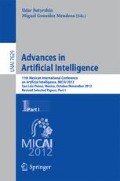Abstract
The original coded image signal can be affected when it is transmitted over error-prone networks. Error concealment techniques for compressed image or video attempt to exploit correctly received information to recover corrupted regions that are lost. If these regions have edges, most of these conventional approaches cause noticeable visual degradations, because they not consider the edge characteristics of images. The spatial error concealment methods cannot work well; especially over high burst error condition since a great of neighboring information have been corrupted or lost (called ‘critical error situations’). This paper proposes two adaptive and effective methods to select the required support area, based on edge analysis using local geometric information, suited base functions and optimal expansion coefficients, in order to conceal the damaged macroblocks in critical error situations. Experimental results show that the proposed two approaches outperform existing methods by up to 7.9 dB on average.
Access this chapter
Tax calculation will be finalised at checkout
Purchases are for personal use only
Preview
Unable to display preview. Download preview PDF.
References
Richardson, I.E.G.: H.264 and MPEG-4 Video Compression, Video Coding for Next–generation Multimedia. John Wiley & Sons, Ltd. (2004)
Wang, Y., Zhu, Q.-F.: Error Control and Concealment for Video Communication: A Review. Proceedings of the IEEE 86(5), 985–995 (1998)
Kumar, S., Xu, L., Mandal, M.K., Panchanathan, S.: Error Resiliency Schemes in H.264/AVC standard. Visual Communications & Image Representation 17(2) (2006)
Varsa, V., Hannuksela, M.M., Wang, Y.K.: Non-normative error concealment algorithms. ITU-T VCEG-N62 (September 2001)
Joint Video Team (JVT) of ISO/IEC MPEG & ITU-T VCEG: Draft ITU-T Recommendation and Final Draft International Standard of Joint Video Specification (ITU-T Rec. H.264 –ISO/IEC 14496-10 AVC), Doc. JVT-G050r1 (May 2003)
Wiegand, T., Sullivan, G.J., Bjøntegaard, G., Luthra, A.: Overview of the H.264/AVC Video Coding Standard. IEEE Trans. Circ. and Syst. for Vid. Tech. 13(7) (July 2003)
Nemethova, O., Al-moghrabi, A.: Flexible Error Concealment for H.264 Based on Directional Interpolation, Wir. Networks. In: Int. Conf. on Comm. and Mob. Comp. (2005)
Kwok, W., Sun, H.: Multi-Directional Interpolation for Spatial Error Concealment. IEEE Trans. on Cons. Electr. 39(3), 455–460 (1993)
Kaup, A., Meisinger, K., Aach, T.: Frequency selective signal extrapolation with applications to error concealment in image communication. Int. J. of Elect. Comm. 59, 147–156 (2005)
Meisinger, K., Kaup, A.: Minimizing a weighted error criterion for spatial error concealment of missing image data. In: Proc. IEEE Int. Conf. on Image Proc., ICIP 2004, pp. 813–816 (2004)
Meisinger, K., Kaup, A.: Spatial error concealment of corrupted image data using frequency selective extrapolation. In: ICASSP, pp. 209–212 (May 2004)
Kaup, A., Aach, T.: Efficient prediction of uncovered background in inter frame coding using spatial extrapolation. In: ICASSP, pp. 501–504 (April 1994)
Kaup, A., Aach, T.: Coding of segmented images using shape independent basis functions. IEEE Trans. Image Process. 7, 937–947 (1998)
H.264/AVC Codec Software: JM14.2 Video Coding Standard
Suh, J.W., Ho, Y.S.: Error concealment based on directional interpolation. IEEE Trans. Consumer Electron. 43(3), 295–302 (1997)
Author information
Authors and Affiliations
Editor information
Editors and Affiliations
Rights and permissions
Copyright information
© 2013 Springer-Verlag Berlin Heidelberg
About this paper
Cite this paper
Ramírez-Acosta, A.A., García-Vázquez, M.S. (2013). Two Adaptive Methods Based on Edge Analysis for Improved Concealing Damaged Coded Images in Critical Error Situations. In: Batyrshin, I., González Mendoza, M. (eds) Advances in Artificial Intelligence. MICAI 2012. Lecture Notes in Computer Science(), vol 7629. Springer, Berlin, Heidelberg. https://doi.org/10.1007/978-3-642-37807-2_14
Download citation
DOI: https://doi.org/10.1007/978-3-642-37807-2_14
Publisher Name: Springer, Berlin, Heidelberg
Print ISBN: 978-3-642-37806-5
Online ISBN: 978-3-642-37807-2
eBook Packages: Computer ScienceComputer Science (R0)

